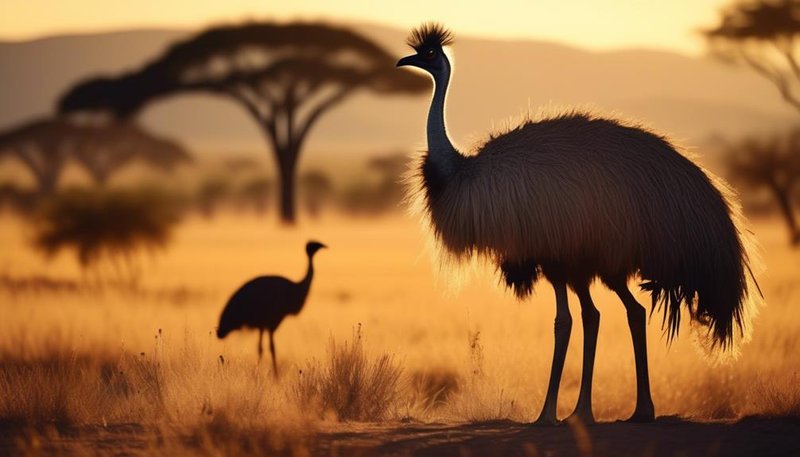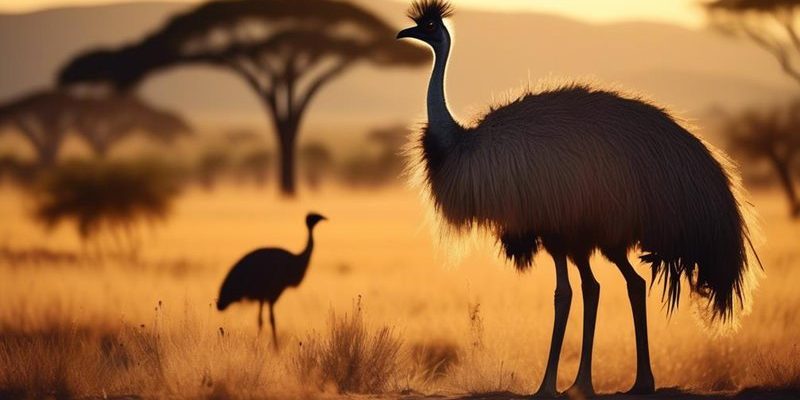
So, you might be wondering, “Is the emu endangered?” To answer that question, we need to dive deep into the world of wildlife conservation and see what’s really happening with these fascinating birds. Think of this as a journey through the challenges and efforts surrounding emu preservation, exploring both the threats they face and the actions being taken to keep them safe.
The Current Status of Emus
Let’s start with the big picture: the emu is not currently classified as endangered. According to the IUCN (International Union for Conservation of Nature), emus are listed as “Least Concern.” This means that, at present, they aren’t facing immediate extinction risks on a broad scale. But that doesn’t mean it’s all clear sailing for them.
Despite their stable numbers, emus still encounter various pressures. Habitat loss, primarily due to agriculture and urban expansion, has a significant impact. Imagine a sprawling wheat field where emus once roamed freely; as these lands are converted into farmland, emus lose not only their home but also their food sources. Conservationists argue that it’s crucial to keep an eye on these changes to ensure that emus continue to thrive.
Habitat Loss and Its Impact
Habitat loss isn’t just a buzzword—it’s real and has dire consequences for many species, including the emu. As Australian cities grow and farming practices expand, emus find themselves squeezed into smaller and smaller spaces. This shrinkage can lead to competition for food and resources, which can affect their overall health and reproduction.
Additionally, when emus are pushed out of their natural habitat, they often wander into farmland, where they can become pests. Farmers may resort to drastic measures to protect their crops, which can further endanger emu populations. The balance between agriculture and wildlife conservation is delicate, and finding a solution that works for both sides is critical.
Threats from Introduced Species
Another significant threat to emus comes from introduced species, such as dingoes and feral pigs. These animals can disrupt emu habitats and even prey on their young. Imagine a dingo prowling around where emus nest—this added pressure means that emus have to be extra vigilant about their surroundings.
Feral pigs, on the other hand, can ruin the ground where emus forage for food. They dig in the dirt, uprooting plants and disturbing the ecosystem. It’s a bit like throwing a party in your living room and realizing someone is stomping all over the snacks. Addressing these introduced species is a crucial part of conserving emus.
Conservation Efforts in Place
Fortunately, many organizations are dedicated to protecting emus and their habitats. From local wildlife groups to national parks, efforts are underway to enhance conservation measures. For example, creating wildlife corridors and protected areas can help emus migrate safely and access vital resources.
Moreover, public awareness campaigns are increasingly vital. When people understand the challenges facing emus, they’re more likely to support conservation initiatives. Community involvement, such as citizen science projects, allows individuals to contribute to data collection and monitoring efforts. Imagine a group of local bird enthusiasts helping track emu populations—it’s a win-win!
The Role of Indigenous Knowledge
Indigenous Australians have long had a deep connection with emus and their habitats. Their traditional knowledge can offer invaluable insights into sustainable practices and land management. By listening to Indigenous voices, conservationists can gain a deeper understanding of how to protect these birds in ways that respect both nature and culture.
Combining scientific research with Indigenous wisdom has proven effective in many conservation efforts around the world. Emus are no exception; when we involve local communities and respect their knowledge, we create more holistic strategies for conservation that benefit everyone.
Future Challenges for Emus
Looking ahead, emus will likely face new challenges as climate change continues to affect ecosystems. Changes in weather patterns can impact food availability and nesting areas. Think of it like trying to find your favorite restaurant, only to discover it’s moved to a different neighborhood—you’d need to adjust your plans.
Additionally, as urban areas expand, the risk of vehicle strikes on roads that cross emu habitats increases. Raising awareness about these risks is essential to mitigate their impact. Implementing measures such as wildlife crossings can help emus navigate their environments more safely.
What Can You Do to Help?
You might be thinking about how you can pitch in to help emus thrive. Here are a few simple ways you can make a difference:
- Support local conservation groups working to protect wildlife and their habitats.
- Participate in or volunteer for community clean-up events in natural areas.
- Educate yourself and others about the importance of biodiversity and how it affects our ecosystem.
- If you’re visiting Australia, support eco-friendly tourism that prioritizes wildlife conservation.
Every small action counts! When we come together, we can create a more sustainable environment for emus and other wildlife.
In conclusion, while emus are currently not classified as endangered, their future is entwined with the health of their habitats and the various challenges they face. Conservation efforts are crucial in ensuring these incredible birds continue to thrive. By working together and respecting the ecosystems they call home, we can help secure a future where emus continue to roam freely across the Australian landscape.

